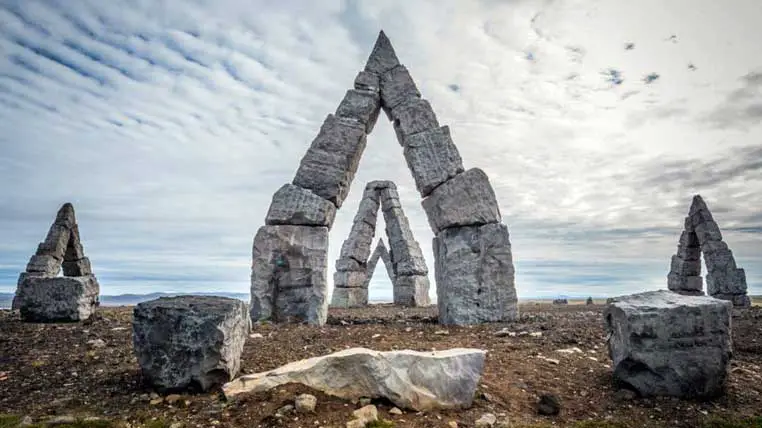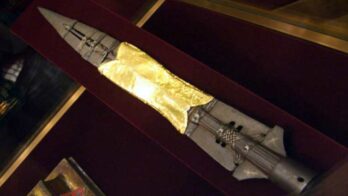In the French region of Brittany, at Carnac, over 4,000 enormous stone slabs dating back almost 6,000 years can be found.
Some of the slabs are isolated, others are aligned in perfect rows, and others mark the location of burial chambers underneath mounds.
The burial chamber complexes in Ireland and the 12,000 ancient compartmentalized burial sites beneath mounds in northern Europe contain stone arrangements corresponding to solar and lunar cycles.
What Is a Megalith?
All of these ancient structures are known as megaliths, a term derived from the old Greek word “megas,” meaning “great,” and “lithos,” meaning “stone.”
A megalith is a large, prehistoric stone monument, typically made of a single stone or several stones arranged in a specific formation.
They were erected in various parts of the world during the Neolithic and Bronze Age periods, between 4000 and 1500 BCE.
Some of the most famous megaliths in the world include:
- Stonehenge – located in Wiltshire, England, Stonehenge is a prehistoric monument consisting of a ring of standing stones, each around 13 feet high and weighing around 25 tons.
- The Moai statues of Easter Island – located in the Pacific Ocean, Easter Island is home to almost 900 massive stone statues, many of which were carved between 1250 and 1500 CE.
- Callanish Stones – located on the Isle of Lewis in Scotland, Callanish is a standing stone complex dating back to 2900 BCE.
- Newgrange – located in County Meath, Ireland, Newgrange is a passage tomb built around 3200 BCE. It is known for its elaborate roof box, which allows sunlight to penetrate the inner chamber during the winter solstice.
- Carnac Stones – located in Brittany, France, the Carnac Stones are a collection of thousands of standing stones arranged in lines and patterns stretching for miles.
- Dolmens of Antequera – located in Andalusia, Spain, the Dolmens of Antequera are a group of three megalithic structures that date back to around 2500 BCE.
- Göbekli Tepe – located in southeastern Turkey, Göbekli Tepe is a complex of stone circles and T-shaped pillars that date back to around 9500 BCE, making it one of the oldest known megalithic structures in the world.
Mysterious Prehistoric Monuments
Interestingly, some megaliths predate even the Egyptian pyramids.
The mystery of these ancient structures is compounded by the assumption that they were constructed by people who were believed not to have had the knowledge and technology to move such massive slabs.
Moreover, most megalithic structures required architectural and mathematical skills to design and craft, even if a certain labor force was available.
Many prehistoric megaliths also appear to have had sophisticated uses, such as solar and lunar calendars or astronomical observatories.
In fact, the discipline of archaeoastronomy, which is the study of astronomy in ancient societies, has flourished in recent decades, with megaliths at its center.
Prehistoric megaliths are generally divided into five categories:
- Alignments, which are slabs arranged in rows and other non-circular forms;
- Burial Chambers, which are underground chambers usually covered with a mound;
- Monoliths, which are single-standing stones, also known as menhirs;
- Memorials, which are structures dedicated to the gods or leaders of the community;
- Stone Circles, such as the construction at Stonehenge.
As researchers study ancient megaliths, their appreciation for the knowledge and craftsmanship of prehistoric civilizations grows.
Nevertheless, there are still many missing pieces in the human development puzzle, fueling various speculations and theories.
Some suggest that the survivors of vanished civilizations passed on their knowledge to the inhabitants of distant lands.
As some ancient myths suggest, the megalith builders may have known the magical secrets of levitation, transformation, and reassembly of solid materials.
In fact, enthusiasts of the UFO phenomenon suggest that visitors from other worlds directed the raising of megaliths, mainly since many megalithic sites were intended for viewing and mapping the sky.

Stonehenge
Stonehenge is a prehistoric stone circle monument, burial ground, and archaeological site located on Salisbury Plain, Wiltshire, England, about 8 miles (13 km) north of Salisbury.
Though its intended purpose remains a mystery, it was likely a religious site and an expression of power and wealth.
Many chieftains, aristocrats, and priests who had it built were buried in the nearby barrows.
Stonehenge was aligned with the Sun and potentially used for observing the Sun and Moon, working out the farming calendar, as a healing center, or dedicated to the world of the ancestors separated from the living.
Though there is doubt about whether it was used by Druids, present-day Druids gather there yearly to hail the midsummer sunrise.
The entrance in the northeast points to the midwinter sunset and the Heel Stone, while the opposite direction points to the summer solstice, celebrated annually by vast crowds of visitors.
The monument was built in six stages between 3000 and 1520 BCE, during the transition from the Neolithic Period to the Bronze Age.
Stonehenge is unique as a prehistoric stone circle because of its artificially shaped sarsen stones arranged in a post-and-lintel formation and its smaller bluestones from South Wales, over 100–150 miles (160–240 km) away.
It is believed that the name Stonehenge derives from the Saxon stan-hengen, meaning “stone hanging” or “gallows.”
Along with over 350 nearby monuments and henges, including the Avebury temple complex, it was designated a UNESCO World Heritage site in 1986.
Theories about the meaning and significance of Stonehenge have evolved over time.
In the 17th and 18th centuries, English antiquarians John Aubrey and William Stukeley believed the structure to be a Druid temple. Archeologists and historians have rejected this theory as Stonehenge predates the Druids by around 2,000 years.
Despite its mystery, Stonehenge remains an important and fascinating historical site.
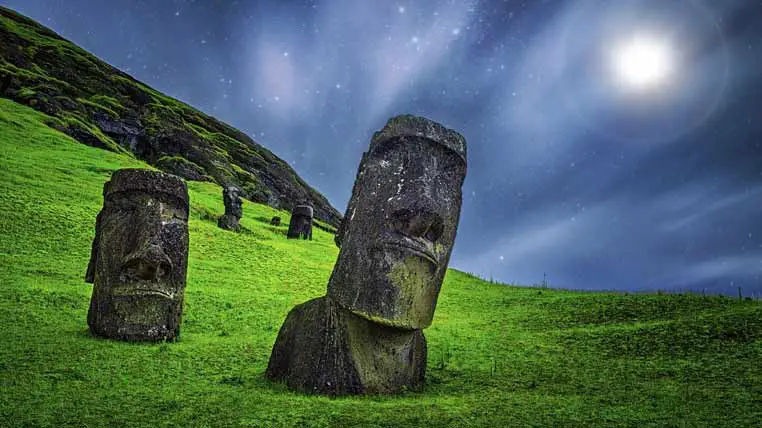
The Moai Statues of Easter Island
Easter Island, also known as Rapa Nui, is home to over 1,000 monumental statues called moai. These enigmatic and towering figures, made of volcanic stone, are one of the world’s most recognizable and mysterious archaeological wonders.
Contrary to popular belief, moai are not just heads, but full-bodied figures with prominent heads and torsos.
Standing on average 13 feet tall and weighing 10 metric tons, the statues are often found standing with their backs to the sea on stone platforms called ahu.
Some of the moai are adorned with cylindrical red stones called pukao, representing a topknot of hair.
While over 1,000 moai have been discovered on the island, the number remains unknown as many remain buried in the Rano Raraku quarry on the island’s south shore.
The largest moai ever discovered, “El Gigante,” is 69 feet tall and is thought to weigh around 200 metric tons. Unfortunately, it never made it out of the quarry.
Moai were erected hundreds of years before the arrival of the first Europeans on Easter Island in 1722.
Archaeologist Jo Anne Van Tilburg believes that Polynesians discovered the island around AD 1000 and developed advanced social, political, and religious systems that produced the noble moai.
The Rapa Nui people believed that their chiefs were descended from the gods and that, after death, they would once again become divine.
The statues were built to temporarily contain the spirits of their ancestors, and the ahu upon which they stand were once the sites of death rituals. Excavations have found cremated and buried human remains at some of these sites.
Van Tilburg has a personal theory that the moai were containers in which these moving spirits could be captured and held safe so that they could continue to aid the people left behind.
A clear connection between the moai of Rapa Nui and similar megaliths found around Polynesia indicates a shared religious belief system.
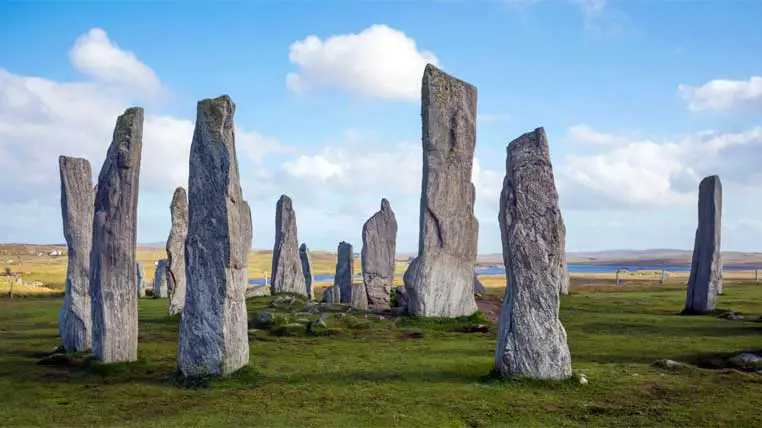
Callanish Stones
If you’re a fan of Outlander, you may have come across Scotland’s famous standing stone circles.
These intriguing megalithic formations have been shrouded in mystery for centuries and continue to fascinate people to this day.
Located on the scenic island of Lewis, over 20 monoliths were built between 3,000 and 4,000 years ago, but the most famous of all is the Calanais standing stones.
This incredible cross-shaped formation of stones was erected around 5,000 years ago, predating even England’s well-known Stonehenge monument.
The Calanais was an important location for ritual activities for at least 2,000 years.
The complex arrangement of over 50 stones forms a cross with a central circle at the center.
The prominent megaliths form the heart of the formation, with 13 stones standing between 8 and 13 feet tall, surrounding the tallest stone on the site. The impressive 16-foot-high stone weighs over 5.5 tons and will leave visitors in awe.
Despite many theories, the purpose of the standing stones remains a mystery.
However, the most widely accepted theory is that they were used as an astronomical observatory.
The double rows of stones that extend in a cross formation from the central circle were likely used to mark significant points in the lunar cycle.
The standing stones and the north avenue were built around 2000 BC, while the three single lines and a tomb were added around 1500 BC.
However, by 800 BC, the site had lost its special significance, and a small settlement was built nearby.
Climate change had taken its toll on the site, with peat growing across the area for some 500 years, and some of the stones were entirely buried by the land’s changing shape.
By the time the peat was cleared from the site in 1857, it was nearly 6 feet deep!

Newgrange
Located just an hour’s drive north of Dublin, Newgrange is a magnificent feat of prehistoric engineering revered for its remarkable astronomical alignments.
Every year on December 21st, visitors flock to this megalithic marvel to witness one of the world’s oldest and most spectacular light shows.
Newgrange is a Neolithic monument that was constructed around 3200 BC, making it six centuries older than the oldest pyramid in Egypt and seven hundred years older than Stonehenge.
It is an integral part of the prehistoric complex known as Brú na Bóinne, which translates to the “Palace of the Boyne.”
This passage tomb comprises 200,000 tons of material and has a footprint of over an acre, a testament to the engineering, artistic, and astronomical abilities of its builders, as well as their religious beliefs.
While the consensus is that native Irish people constructed Newgrange, numerous radical and fascinating theories suggest otherwise.
Some have speculated that Vikings, Phoenicians, Egyptians, or Romans may have been the colonist-builders of this remarkable site.
Despite the ongoing debates about the origins of its builders, there is no denying Newgrange’s awe-inspiring beauty and significance. It continues to captivate visitors with its stunning astronomical alignments and remains an important symbol of Ireland’s rich prehistoric heritage.
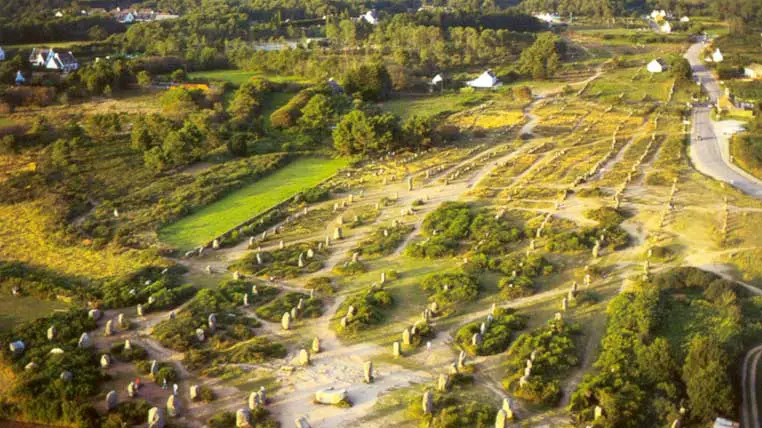
The Megaliths of Carnac, France
The Carnac Alignments, located along the Brittany coast and spanning 4km, comprise over 3,000 menhirs – tapered, man-made stones erected during prehistoric times across Western Europe.
They are the most extensive collection of man-made standing stones worldwide and remain shrouded in mystery, similar to Stonehenge, regarding their purpose, meaning, and creators.
Despite the many theories, their significance remains unknown.
Carbon dating places the granite menhirs’ construction around 6,000 years ago by a Neolithic community, a millennium earlier than Stonehenge.
The stones vary in height, with the largest, Giant of Manio, reaching 6 meters and weighing five to 10 tons. The stones were quarried from nearby bedrock and erected using brute force and pulleys.
The Carnac Alignments, which are meandering and follow a ridge separating coastal plains from the interior, marked a symbolic border between the land and sea, signifying their cultural importance.
Although stories of Korrigans, goblin-like creatures, and stone soldiers crushing anyone in their path to drink from a stream on Christmas Eve were used to explain the unknown, the site’s ceremonial or religious significance remains a subject of interpretation.
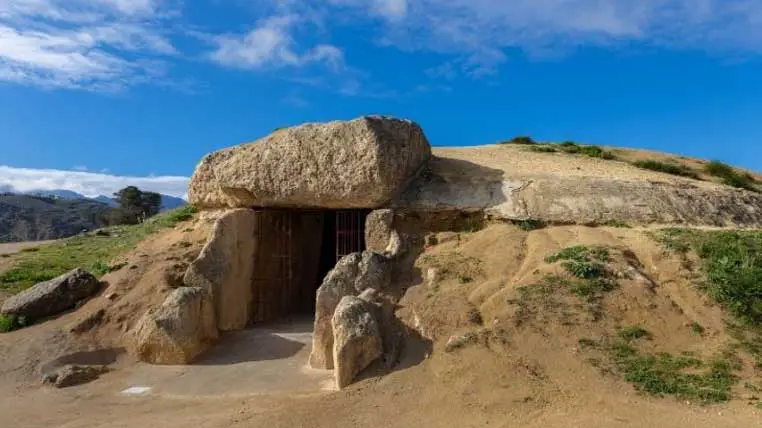
Dolmens of Antequera
The Dolmens of Antequera Site in Spain, dating back to the Neolithic Age, houses the renowned Dolmen of Menga, a megalithic burial mound known as a tumulus.
The entrance of this long barrow form of a dolmen is made up of a colossal trilith, dating back to roughly 3750-3650 BC.
This site, along with the Matacabras shelter and its cave paintings, is believed to have served as a sacred space for the Neolithic communities of the region before the construction of the grand Menga dolmen.
The Menga Dolmen is one of the largest megalithic structures in Europe.
Constructed with thirty-two megaliths, the Menga Dolmen is 27.5 meters (90 ft) long, 6 meters (20 ft) wide, and 3.5 meters (11 ft) high.
The largest megalith weighs about 200 tons, and the entire structure is covered with a tumulus measuring 50 meters in diameter. The stone structure was covered with soil and built into the hill we see today.
Unlike 95 percent of the megalithic monuments in southern Iberia, Menga was not oriented towards the sunrise.
Instead, it is slightly north of the summer solstice, pointing towards La Peña de Los Enamorados, a prominent mountain in the Antequera plain.
Archaeologists from the University of Seville discovered a small cave near this mountain with both visual and symbolic links leading to the Menga dolmen.
The reason for constructing this extraordinary monument remains a mystery.
Did the chamber serve as a tomb for the royal families?
In the 19th century, archaeologists excavated in the Menga area, opened the grave, and found the skeletons of several hundred individuals inside.
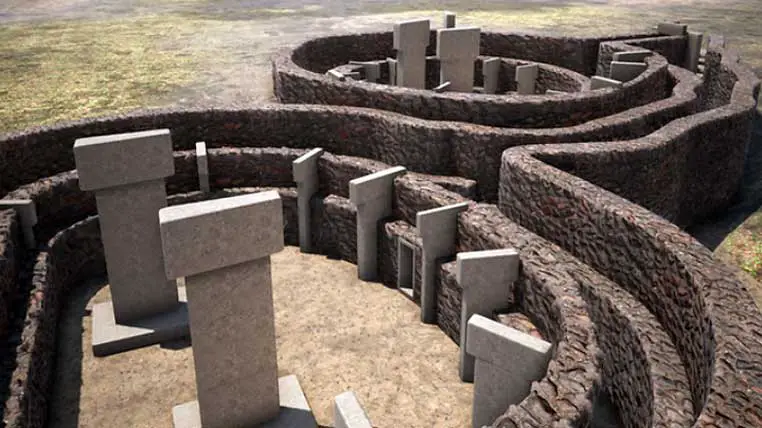
Göbekli Tepe
Located in eastern Turkey, Göbekli Tepe is a site that challenges everything we thought we knew about the origins of civilization.
This hilltop temple complex in the semi-barren desert is shrouded in mystery and intrigue, with many revelations yet to be decrypted.
Despite ongoing excavations, the site has already provided glimpses into humanity’s origins, causing a paradigm shift that will transform our vision of history.
Spread over 20 acres, Göbekli Tepe is a sprawling temple complex with many stone circles, each with multiple layers of history.
On the oldest level, circular compounds, known as temenes, range from 10 to 30 meters in diameter. They are adorned with monolithic T-shaped stones, some weighing up to 50 tons.
But that’s not all – these stones are intricately decorated with sculptures of animals, so intricate that they could rival those of a Renaissance master.
Göbekli Tepe seems to be the cradle of an ancient religion, the Mecca of its time. Since its discovery in 1996, several smaller imitations have been found in the surrounding area.
Still, Göbekli Tepe was the first, the largest, and the heart of the previously unknown religion – the cathedral of this ancient world. It dates back to around 9,600 BC, making it older than the pyramids by 7,000 years and Stonehenge by 6,000 years.
However, even more surprising is that it predates the domestication of crops, which means that the people who built it were hunter-gatherers.
The idea of hunter-gatherers constructing megalithic temples was unheard of before the discovery of Göbekli Tepe.
These circular compounds fundamentally challenge the traditional narrative of the history of civilization.
With no signs of habitation at the site, the archaeologists leading the dig have proposed a radical hypothesis: what if Göbekli Tepe not only predates the agricultural revolution but caused it?
As Stanford University’s head of archaeology aptly said, “Many people think that it changes everything…It overturns the whole apple cart. All our theories were wrong.”
Despite ongoing excavations, Göbekli Tepe has already revolutionized our understanding of humanity’s origins, and the site is poised to reveal many more mysteries that will transform our view of history.
At Ancient Theory we only use trusted sources to document our articles. Such relevant sources include authentic documents, newspaper and magazine articles, established authors, or reputable websites.
- Aubrey Burl - Megalithic Brittany: A Guide to over 350 Ancient Sites and Monuments. Thames and Huston, London, 1985.
- Daniel Edmund Glyn - Megaliths in History. Thames and Huston, London, 1972.
- Peter Brown Lancaster - Megaliths, Myths and Men: An Introduction to Astroarchaeology. Dover Publishing, New York, 2000.
- Jean-Pierre - The World of Megaliths. Facts on File, New York, 1990.
- Stonehenge - wikipedia.org. [Source]
